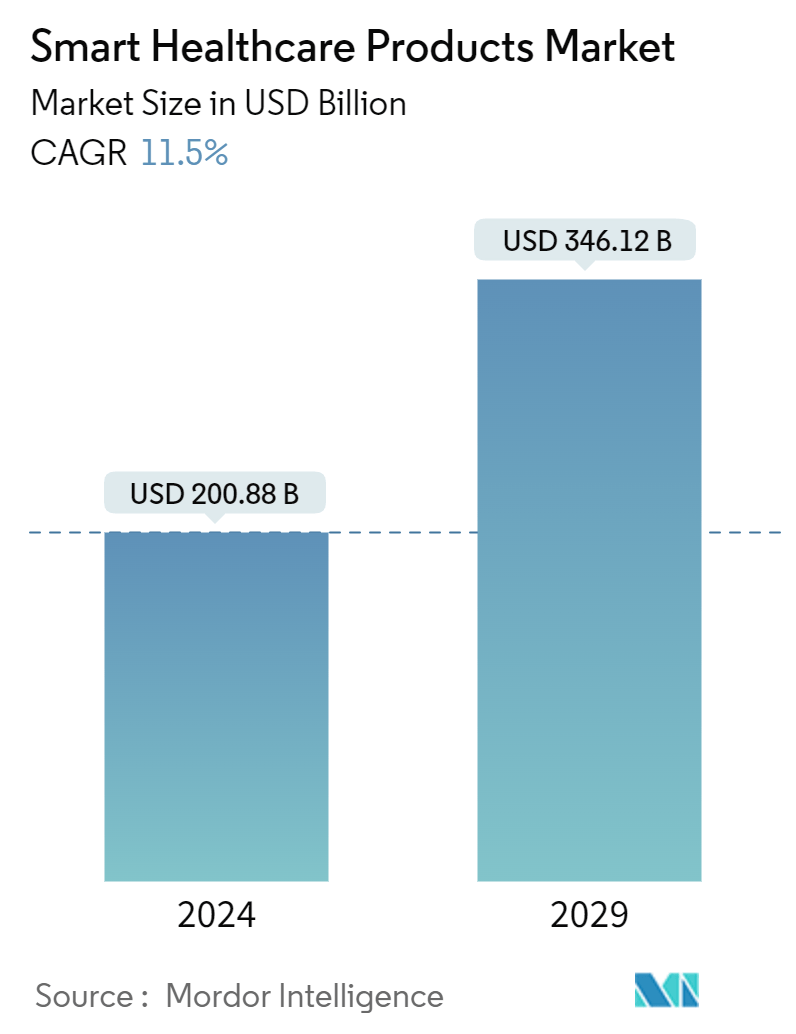Market Size of Smart Healthcare Products Industry

| Study Period | 2019 - 2029 |
| Market Size (2024) | USD 200.88 Billion |
| Market Size (2029) | USD 346.12 Billion |
| CAGR (2024 - 2029) | 11.50 % |
| Fastest Growing Market | Asia-Pacific |
| Largest Market | North America |
Major Players
*Disclaimer: Major Players sorted in no particular order |
Smart Healthcare Market Analysis
The Smart Healthcare Products Market size is estimated at USD 200.88 billion in 2024, and is expected to reach USD 346.12 billion by 2029, growing at a CAGR of 11.5% during the forecast period (2024-2029).
With the emergence of COVID-19, smart healthcare products observed a sudden upsurge in demand. As a result, many companies are expanding their products and services. For instance, according to a study published in IEEE Access in January 2022, a smart health monitoring system was developed using Internet of Things (IoT) technology, which is capable of monitoring blood pressure, heart rate, oxygen level, and temperature of a person, thus helping manage COVID-19 patients. The demand for smart health products increased during the pandemic, which significantly influenced the market's growth. The market is also projected to expand in the following years due to an increase in the use of smart healthcare products to effectively monitor health outcomes, along with the development of technologically advanced products that encourage customers to purchase these devices.
Smart healthcare products are based on the new generation of information technologies, such as the internet of things (loT), big data, cloud computing, and artificial intelligence, to transform the traditional medical system and make healthcare more efficient, convenient, and personalized. Smart healthcare products are undergoing technological developments due to their increasing penetration in the healthcare market. Various initiatives by public and private players, such as product launches and approvals, are also driving the growth of the market. For instance, in January 2021, Apple Inc. partnered with Biogen, a biotechnology company, for a study on detecting the signs of cognitive impairment early through its wearable devices. Similarly, in November 2021, Honeywell launched the Real-Time Health Monitoring System (RTHMS), a smart edge-to-cloud communication platform that acts as a bridge between caregivers and patients for remote and real-time monitoring of patients. The solution combines hardware and software to improve care delivery, increase worker productivity, and streamline processes.
The growing adoption of IoT in healthcare is expected to boost the market. In healthcare, IoT applications benefit patients, families, physicians, hospitals, and insurance companies. According to the study published in Oral Biology and Craniofacial Research in April 2022, IoT is a developing technology that delivers enhancements and improved solutions in the medical area, such as proper medical record-keeping, sample, device integration, and illness causes. Sensor-based IoT technology has the potential to significantly minimize the risk of surgery in complex circumstances. Thus, such advantages are expected to raise the demand for IoT-based smart healthcare products, thereby boosting the growth of the market.
However, high cost of smart healthcare products may restrain the market over the forecast period.
Smart Healthcare Industry Segmentation
As per the scope of the report, smart healthcare products improve outcomes related to diagnostic tools and enhance patient treatment, along with improving their quality of life. Smart health products come with embedded communication, sensor technologies, and data analytics techniques. These products are used for monitoring individuals physically for diagnosis and ongoing disease treatments.
The smart healthcare products market is expected to register a CAGR of 8.5% over the forecast period. The smart healthcare products market is segmented by product type (telemedicine, electronic health records, mHealth, smart pills and syringes, and smart RFID cabinets), application (storage and inventory management, monitoring, treatment, and other applications), end user (hospitals, home care settings, and other end users), and geography (North America, Europe, Asia-Pacific, Middle East and Africa, and South America). The market report also covers the estimated market sizes and trends for 17 different countries across major regions globally. The report offers the market size and forecasts in value (USD million) for the above segments.
| By Product Type | |
| Telemedicine | |
| Electronic Health Records | |
| mHealth | |
| Smart Pills and Syringes | |
| Smart RFID Cabinets | |
| Other Product Types |
| By Application | |
| Storage and Inventory Management | |
| Monitoring | |
| Treatment | |
| Other Applications |
| By End User | |
| Hospitals | |
| Home Care Settings | |
| Other End Users |
| By Geography | ||||||||
| ||||||||
| ||||||||
| ||||||||
| ||||||||
|
Smart Healthcare Products Market Size Summary
The smart healthcare market is experiencing significant growth, driven by the increasing integration of advanced technologies such as the Internet of Things (IoT), big data, cloud computing, and artificial intelligence into healthcare systems. This transformation aims to enhance the efficiency, convenience, and personalization of healthcare services. The COVID-19 pandemic acted as a catalyst, accelerating the demand for smart healthcare products as they proved essential in monitoring and managing health outcomes. Companies are expanding their offerings, with initiatives like Apple's collaboration with Biogen and Honeywell's Real-Time Health Monitoring System exemplifying the industry's push towards innovative solutions. Despite the high costs associated with these products, the market is poised for expansion due to the growing adoption of IoT applications, which offer substantial benefits in areas such as medical record-keeping and patient monitoring.
The mHealth segment, a subset of eHealth, is also witnessing robust growth, fueled by the rising use of smartphones and tablets. Initiatives like Athenahealth's partnership with Smile Foundation to provide mobile healthcare services in Chennai highlight the increasing adoption of digital health technologies. Product launches, such as Mount Sinai Health System's MyMountSinai app, further propel the segment's expansion. The North American region is expected to lead the market growth, supported by favorable government policies, high digital literacy, and the widespread use of health-related apps. Continuous product innovations, like RespiraLabs' AI-powered wearable lung monitor, are anticipated to drive market growth, particularly in addressing chronic diseases. The market remains moderately competitive, with key players focusing on new product developments and strategic collaborations to strengthen their market presence.
Smart Healthcare Products Market Size - Table of Contents
-
1. MARKET DYNAMICS
-
1.1 Market Overview
-
1.2 Market Drivers
-
1.2.1 Technological Advancements in Smart Healthcare Products
-
1.2.2 Booming Internet of Things (IoT) in the Healthcare Industry
-
-
1.3 Market Restraints
-
1.3.1 High Cost of Smart Healthcare Products
-
-
1.4 Industry Attractiveness - Porter's Five Forces Analysis
-
1.4.1 Threat of New Entrants
-
1.4.2 Bargaining Power of Buyers/Consumers
-
1.4.3 Bargaining Power of Suppliers
-
1.4.4 Threat of Substitute Products
-
1.4.5 Intensity of Competitive Rivalry
-
-
-
2. MARKET SEGMENTATION (Market Size by Value - USD million)
-
2.1 By Product Type
-
2.1.1 Telemedicine
-
2.1.2 Electronic Health Records
-
2.1.3 mHealth
-
2.1.4 Smart Pills and Syringes
-
2.1.5 Smart RFID Cabinets
-
2.1.6 Other Product Types
-
-
2.2 By Application
-
2.2.1 Storage and Inventory Management
-
2.2.2 Monitoring
-
2.2.3 Treatment
-
2.2.4 Other Applications
-
-
2.3 By End User
-
2.3.1 Hospitals
-
2.3.2 Home Care Settings
-
2.3.3 Other End Users
-
-
2.4 By Geography
-
2.4.1 North America
-
2.4.1.1 United States
-
2.4.1.2 Canada
-
2.4.1.3 Mexico
-
-
2.4.2 Europe
-
2.4.2.1 Germany
-
2.4.2.2 United Kingdom
-
2.4.2.3 France
-
2.4.2.4 Spain
-
2.4.2.5 Italy
-
2.4.2.6 Rest of Europe
-
-
2.4.3 Asia-Pacific
-
2.4.3.1 China
-
2.4.3.2 Japan
-
2.4.3.3 India
-
2.4.3.4 Australia
-
2.4.3.5 South Korea
-
2.4.3.6 Rest of Asia-Pacific
-
-
2.4.4 Middle East and Africa
-
2.4.4.1 GCC
-
2.4.4.2 South Africa
-
2.4.4.3 Rest of Middle East and Africa
-
-
2.4.5 South America
-
2.4.5.1 Brazil
-
2.4.5.2 Argentina
-
2.4.5.3 Rest of South America
-
-
-
Smart Healthcare Products Market Size FAQs
How big is the Smart Healthcare Products Market?
The Smart Healthcare Products Market size is expected to reach USD 200.88 billion in 2024 and grow at a CAGR of 11.5% to reach USD 346.12 billion by 2029.
What is the current Smart Healthcare Products Market size?
In 2024, the Smart Healthcare Products Market size is expected to reach USD 200.88 billion.

